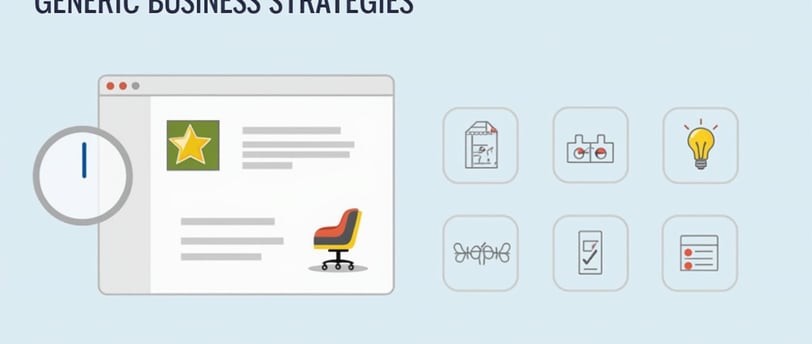What Are Two Generic Business Strategies? A Comprehensive Guide
In today’s competitive business world, companies must develop strategies to differentiate themselves and achieve long-term success. One popular framework, introduced by Michael Porter, outlines two primary generic business strategies: cost leadership and differentiation. These strategies have become essential tools for businesses looking to secure a sustainable competitive advantage. But what are these strategies, and how do they work?
Two Generic Business Strategies
1/11/20253 min read


Understanding Generic Business Strategies
Definition and Purpose
Generic business strategies are fundamental approaches that organizations adopt to achieve a competitive edge in their industries. These strategies focus on how a company can provide value to its customers while remaining profitable.
Origins of Generic Business Strategies
Michael Porter, a renowned economist, introduced the concept of generic strategies in his 1980 book, Competitive Strategy: Techniques for Analyzing Industries and Competitors. Porter emphasized that businesses must choose between cost leadership, differentiation, or a focus strategy to remain competitive.
Cost Leadership Strategy
What is Cost Leadership?
Cost leadership involves producing goods or services at the lowest cost while maintaining acceptable quality. Companies following this strategy aim to offer competitive pricing to attract price-sensitive customers.
Key Characteristics of Cost Leadership
Economies of Scale: Cost leaders benefit from large-scale production, reducing per-unit costs.
Efficient Operations: Streamlined processes and optimized supply chains are crucial.
Cost Control: Strict oversight of expenses ensures profitability at lower prices.
Standardized Products: Products often meet basic needs without added frills.
Examples of Successful Cost Leadership
Walmart: Known for its "Everyday Low Prices," Walmart leverages economies of scale and efficient logistics to maintain its cost leadership position.
IKEA: This furniture giant focuses on cost-efficient production and self-service models to keep prices low.
Differentiation Strategy
What is Differentiation?
Differentiation focuses on creating unique products or services that stand out in the market. Companies adopting this strategy prioritize innovation, branding, and customer experience.
Key Characteristics of Differentiation
Unique Features: Products or services offer features that competitors cannot easily replicate.
Premium Pricing: Differentiated offerings often command higher prices due to perceived value.
Strong Branding: A recognizable brand reinforces customer loyalty.
Focus on Quality: Differentiation requires a commitment to high standards.
Examples of Successful Differentiation
Apple: With its innovative technology and sleek design, Apple has built a loyal customer base willing to pay a premium.
Tesla: By focusing on cutting-edge electric vehicles and sustainable energy solutions, Tesla has carved out a unique position in the automotive industry.
Comparing Cost Leadership and Differentiation
Core Differences
AspectCost LeadershipDifferentiationFocusLowering costsCreating uniquenessTarget AudiencePrice-sensitive customersValue-focused customersCompetitive AdvantageOperational efficiencyProduct distinctiveness
Advantages and Disadvantages
Cost Leadership:
Advantages: Broad market appeal, resilience during price wars.
Disadvantages: Risk of quality compromise, vulnerability to innovation.
Differentiation:
Advantages: Strong customer loyalty, higher profit margins.
Disadvantages: High costs, risk of imitation.
Why Are These Strategies Important?
Achieving Competitive Advantage
By excelling in either cost leadership or differentiation, businesses can secure a distinct position in the marketplace, making it harder for competitors to encroach on their territory.
Meeting Customer Needs
Cost leaders appeal to budget-conscious consumers, while differentiators attract those seeking quality and innovation. Both strategies ensure companies effectively address varying customer priorities.
Implementing Generic Business Strategies
Steps to Implement Cost Leadership
Conduct a cost analysis of all operations.
Invest in efficient technologies.
Negotiate favorable supplier contracts.
Standardize products to simplify production.
Steps to Implement Differentiation
Identify market gaps and customer needs.
Invest in research and development.
Build a strong brand presence.
Focus on delivering exceptional customer experiences.
Challenges in Applying Generic Business Strategies
Overcoming Common Pitfalls
For cost leadership: Avoid sacrificing quality for cost savings.
For differentiation: Ensure that added features justify higher prices.
Adapting to Market Changes
Businesses must remain flexible, continually assessing market trends and adjusting their strategies to maintain relevance.
Real-World Applications of Generic Strategies
Case Study 1: A Cost Leader
Southwest Airlines excels in cost leadership by using a single aircraft model to streamline maintenance and operations, passing the savings onto customers.
Case Study 2: A Differentiation Leader
Nike uses innovation and branding to dominate the sportswear market, creating products that resonate with athletes and fashion enthusiasts alike.
Conclusion
Summary of Key Points
The two generic business strategies—cost leadership and differentiation—offer distinct pathways to success. Each strategy caters to different market needs, and businesses must choose the one that aligns with their goals and capabilities.
link- https://amzn.to/4gN8OV5
Final Thoughts
Whether you're a startup or an established enterprise, understanding and implementing these strategies can help you navigate competitive markets and achieve lasting growth.
FAQs
What are the benefits of generic business strategies?
Generic strategies provide a framework for businesses to focus their resources, achieve competitive advantage, and cater to specific customer segments effectively.
Can a company combine cost leadership and differentiation?
While challenging, some companies adopt a hybrid approach. However, it requires careful balancing to avoid diluting either strategy's effectiveness.
How do small businesses apply generic strategies?
Small businesses can focus on niche markets to implement cost leadership or differentiation, tailoring their approach to specific customer needs.
Why are these strategies relevant today?
In a competitive global market, these strategies help businesses remain profitable, adapt to customer demands, and stand out among competitors.
What industries benefit most from generic strategies?
Industries like retail, technology, and hospitality frequently use these strategies to cater to diverse customer preferences and market conditions.


Blog
Content
Engage
contact@growthtimewithme.com
© 2024. All rights reserved.
